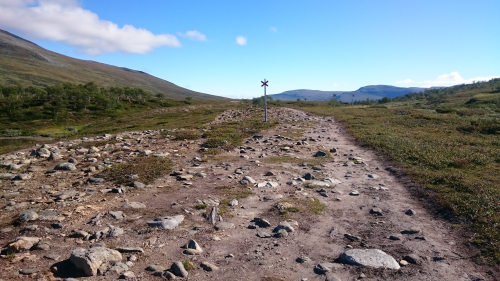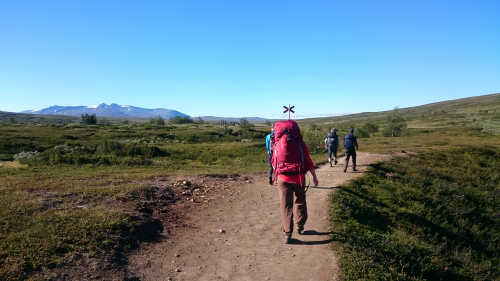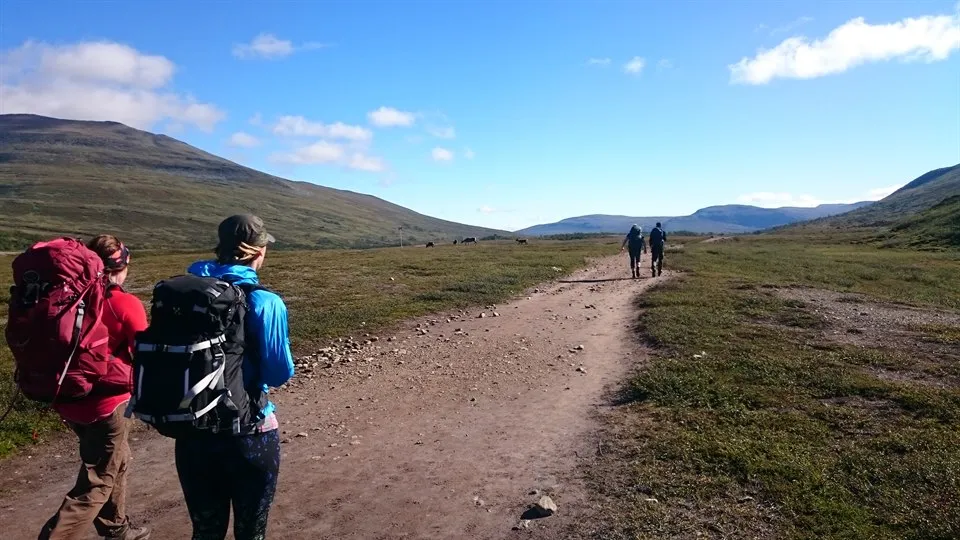Issues of mountain landscape conservation and development continue to be important
“The Swedish mountains are not a landscape of wilderness - humans have left their mark and people still use the landscape in various ways”, says Sandra Wall-Reinius, senior lecturer in human geography.
How to preserve these mountains while at the same time developing them as popular tourist destinations and taking into account local interests is a delicate question, and one to which researchers at ETOUR are trying to find the answer.
A wonderful late summer's day, with Blåhammaren at your back and Storulvån up ahead. A group of hikers on the trail – a herd of reindeer up on the mountain.
Sandra Wall-Reinius is showing pictures from her hikes in the Jämtland mountains together with other researchers, managers and entrepreneurs. The sun is shining in a blue sky, and the Swedish mountains are showing off their best side. At the same time, the pictures also show what Sandra Wall-Reinius and her group of researchers are trying to investigate: how the mountain environment is being affected by human action and how it can best be preserved at the same time as it is being developed with consideration to local societies, and to local and national ambitions and interests.
“We look at the use of the land and the resources it contains, and how the various stakeholders will be able to co-exist”, she explains.

At ETOUR the researchers investigate how human action affects the mountain landscape.
Sandra Wall-Reinius is in the final stage of the phase 2-project Negotiating Pathways to Multifunctional Landscapes, which has been running since 2016. The project is being financed by the Swedish Environmental Protection Agency, and over the years there has been a number of major research studies based on the Swedish mountains at several seats of learning throughout the country. Following the completion of Phase 1 in 2015, the Swedish Environmental Protection Agency wanted more, and so work started on Phase 2.
“This is quite a large project with six researchers at three universities. What unites us is the question of how to preserve the mountain landscape and how to agree on development in this region and which roles the mountain trails can have in this.”
They have chosen two major topics as the object of their research in Phase 2: The process of creating a national park in the south Jämtland mountains, and how the use of mountain trails can help to promote co-existence between the different stakeholders.
The conclusions reached by the researchers will help to inform decision making, for example, for county administrative boards, municipalities and the Swedish Environmental Protection Agency.
Many people involved in the mountain environment
Many actors in and around the mountains have an interest in this area. For example, the reindeer herders use the mountains as pasture for their animals, tourists use them for various recreational activities, and local residents use them for their day-to-day lives and enterprises. Businesses and industries must be able to develop, while at the same time consideration must be shown for issues relating to cultural heritage and environmental protection.
“We are following the process regarding a new national park. Any talk of national parks often includes resistance and challenges, says Sandra Wall-Reinius.
The creation of a national park takes many years, and while the researchers are following the process, they are also investigating what role mountain trails might play in addressing different interests.
“Trails can of course be thought of as something that is very concrete. However, when we started to look into it, we found that there was a need to clarify the historical connection of trails, their contemporary significance, what functions they might have and how they can be improved. There are some trails that are barely visible but which have historical value, and there are others that used to go over suitable terrain, but where the ground is no longer suitable for a trail. There are also tourist trails that cross areas that are important for reindeer-herding.

Hiking trail in the mountains of Jämtland.
Over the years, during which the researchers from ETOUR have been investigating the mountain environment, there has been a process of what Sandra Wall-Reinius refers to as ”sportification” of the mountains. There are now new activities that previously never existed in the mountains and on the mountain lakes. For example, running and cycling in the mountains are becoming increasingly common and just about every year a new competition takes place on a mountain.
“In part there has been a change in visitors' attitudes and activities in the mountains, and there is a considerable demand for more activities, especially in easily-accessible mountain areas. The way in which the land is used has changed, and this is placing new demands on everything from maintenance to logistics. And of course these changes have an impact on the mountain environment and on reindeer herding.”
The conclusions arrived at by the researchers from their meetings with various stakeholders, in discussions with the reference group and in workshops, is that just about all actors are positive about trails and they regard them as important. The trails are an effective tool for reducing negative human impact on both the environment and on fauna.
“The participants agree that if trails are well maintained, people will keep to them, and as a result they can be suitably directed in protected areas”, confirms Sandra Wall-Reinius.
“Another important result that we arrived at is that people see the mountains in many different ways. There are different ideas about what the mountains are or ought to be. This has to be taken into consideration in the decision-making process.”
At the end of April 2018 a final report will be submitted to the Swedish Environmental Protection Agency. The research has also been documented by a film team, and the finished film will be released at about the same time as the final report.

